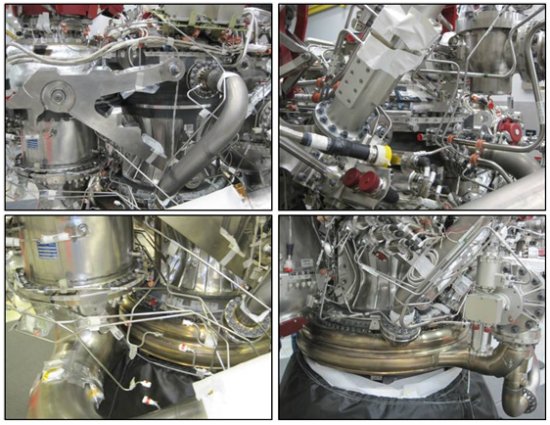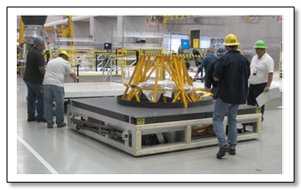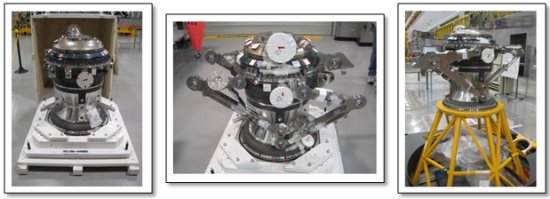J-2X Doghouse: The Rocket Equation! Wahoo!
Welcome back to the J-2X Doghouse. We’ve talked before about what a rocket actually is and we’ve talked about different kinds of rocket engine cycles and where J-2X fits in that family. This time, in response to a couple of early requests on this blog, I’d like to talk about rocket engine performance characteristics and how they relate to successfully getting off the planet and into orbit. Because this comes down to a matter of equations – and therefore at least half of the reading audience will click on their Facebook icon as soon as they see any equations – let me start with an old joke:
Q: What do engineers use for birth control?
A: Their personalities.
Of course you know that joke can’t be entirely true if you’ve read any of the articles profiling the J-2X office. Just about everyone in the office have children. But somewhere, deep down, in order for that joke to have lasted so long, there must be a tiny sliver of truth. Okay, yes, I admit it, here it is: People who become engineers do so for a whole variety of reasons but typically share in common an aptitude towards mathematics and a desire to know how things work.
For me, this whole “future-engineer” notion translated to an appreciation of physics and the representation of the real world, to some approximation, in equations. Seriously, just think about that for a moment. You can pick up a pencil, draw a simple sketch, apply some fundamental laws, and, boom, you’ve got a prediction right there on your paper for how the real world will function. Now that’s darn exciting! At least it is to me. But, okay, word of advice: Showing this level of enthusiasm regarding physics and neato equations is generally NOT good fodder for a first date. Trust me.
However, since I’ve not had a “first date” in over a quarter of a century, I am now going to explain the derivation of the foundational equation for all rocketry: The Rocket Equation. Approximately 99.7% of the world’s population at large does not know this … and, yes, that is a 100% unverified, made-up statistic. Regardless, today you will join an elite, exclusive, and fashionably eccentric club.
[Warning: Some of the mathematics gets a bit heavy here, but some of y’all asked for it.]
First, we start with a simple drawing. Please note that my wife is the artist in the family; I “draw” in PowerPoint. Sorry.

What you have is a thing, a blob, at time equal to t0 with a mass of M moving at a velocity of v. At this point, don’t think of the blob as a rocket. It’s just a thing in an imaginary space where there is no gravity, no friction, no environmental impacts at all.
We then go to the next step in time, time = t0 + dt, where dt is a small increment.
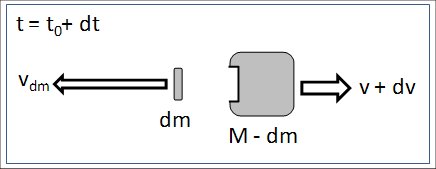
Our blob has ejected from itself a small piece of mass, dm, in the opposite direction from which it was moving. The small mass has a velocity of vdm in the opposite direction of the original blob. The blob, by the way, has a mass now diminished by dm and a velocity that has changed by some increment dv.
Do you want to play the gray blob at home? Okay, do this. On a smooth floor, tile perhaps, sit in a rolling chair holding a basketball. Throw the basketball. You, still in the chair, will roll in the opposite direction from the flight of the basketball. Your initial velocity, v, was zero. Your initial mass, M, included you, the chair, and the basketball. Your new velocity is zero + dv. Your new mass is now minus that of the basketball, dm, flying in the other direction. Ta-da!
Now, how do we turn this simple concept and simplistic drawings into rocket science? Simple, we call up the work of our friend Sir Issac Newton (1642 – 1727). Newton’s First Law of Motion states: “An object at rest tends to stay at rest and that an object in uniform motion tends to stay in uniform motion unless acted upon by a net external force.” I told you that there were no external forces acting on our blob and I drew the box around the whole thing, blob and small piece together. Combining the philosophy of this First Law with the mathematics of the Second Law results in a simple conclusion that in absence of any external forces, momentum is conserved. So, the total momentum in the first drawing is the same as the total momentum in the second drawing with momentum defined as mass × velocity.
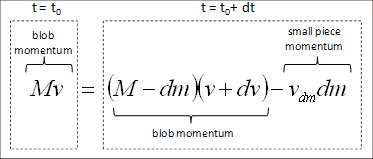
The second term in the right-hand box is negative since the velocity of the small piece is in the opposite direction as the original movement of the blob. Okay, now multiply this all out and eliminate redundant terms and – thanks to some niceties of differential calculus – eliminate second order terms to yield the following:

The dm = -dM switch-a-roo is possible since the incremental change in mass of the blob over the time period dt is exactly the negative of the piece ejected.
Rather than talking in terms of absolute velocity of the blob and the small piece, let’s instead talk in terms of ve, the “ejection velocity” of the small piece. So, this is a relative speed. Then the equation becomes:

Believe it or not, that’s it. In its most rudimentary, simplified form, that the Rocket Equation expressed over a very small time increment dt. If you add up a bunch of these very small time increments, or in other words integrate over a measureable time period [Oh no, integral calculus buried in a blog! Call the blog police!], you get the following:

What does this say? Equations always say something or they’re worthless. It says that the change in velocity of a blob is equal to the relative ejection velocity of small pieces flung away from the blob times the natural log of the ratio of initial mass, M0, to final mass of the blob MF. The natural log thing got in there thanks to the rules of integral calculus. You’ll have to trust me on that one.
Now, what does this have to do with rockets? Well, how about rather than ejecting small discrete chunks of mass we think about what a rocket engine does, which is spew out a continuous stream of mass in the form of high-speed hot gases. The whole derivation above holds for that case with one modification. The hot gases ejecting from the nozzle create a pressure field at the point of ejection. That pressure field creates a force acting on the system. Because there is a force involved now, momentum is not conserved. The derivation is a bit more complicated, but it’s not too bad. The result looks like this:

Where ueq is called the “equivalent exhaust velocity” and is defined as:

The first portion of that last equation deals with the pressure field. Basically, it is the exhaust pressure at the end of the nozzle, Pe, minus the ambient pressure outside, Pa, times the exit area of the nozzle, Ae. Force equals pressure acting over an area. Simple. The “m-dot” term is the mass flow of the hot gases out of the nozzle.
We’re almost there. Really. Hold on.
Next, I want to define thrust. We could have started this way by drawing a control volume around a rocket, but I like starting with the blob. Thrust, T, is the force that the engine imparts on the vehicle. So, it includes the pressure field aspect and it includes the aspect of ejecting hot gases at high speeds. Here it is:

If you put a rocket engine on the test stand, fire it, and measure how hard it pushes against the stand, this is what you are measuring. Sometimes you will see a rocket engine specification that will talk about “vacuum thrust” or “sea level thrust.” The difference between those can be found in the ambient pressure term, Pa, in the equation above. In a vacuum, Pa = 0. At sea level, Pa = 14.7 pounds-force per square inch. Note that depending on your system of measurements, there could be a “g-factor” conversion lurking in the mass flux term so be careful.
Substituting back into the Rocket Equation, we get this:

I have now cleverly introduced the concept of specific impulse, Isp, which is thrust divided by mass flowrate. When talking about rocket engines, we typically describe this parameter as being analogous to gas mileage so that people can understand, but here you can see that it’s an integral part of the basic physics of the acceleration of a rocket vehicle. (Again, beware of hidden g-factor conversions.)
Note that earlier I said that we didn’t have any gravity in our hypothetical situation and that we didn’t have any friction. I can now add these things into our system a simplistic manner to facilitate the final discussion and to present the final equation:

That, right there, believe it or not, tells you 90% of the whole story about how rockets get into orbit and even how they go from there into the rest of the cosmos. What do you need to get into and stay in orbit? A lot of velocity. And this equation tells you all about it. Listen carefully to rocket scientists talking about “delta-v” in movies or the news or in documentaries. “Delta-v” is everything. You need so much delta-v to get to orbit. You need so much delta-v to change orbits. You need so much delta-v to get out of orbit and head towards the moon or anywhere else. Whenever you hear this, they are referring to the Rocket Equation.
Let’s break it down by starting with the last two terms on the right-hand side. These are loss terms and that’s why they are negative. First, as long as you are gaining altitude, you are fighting against gravity. If we had some way to dial down gravity, we could launch rockets more efficiently because this term would lessen (we’d also all float away). That’s intuitive. It takes energy to lift something. Second, as long as you have friction caused by drag against the atmosphere, you’ve got losses. Compared to a vacuum, especially at high speeds, our atmosphere is like soup to a launch vehicle and you need energy to overcome it. Thus, both of these loss terms tell you that for greatest efficiency, it’s best to get up high, out of the atmosphere, and level out to stop fighting gravity as fast as you possibly can. And that’s exactly how we launch rockets. It’s not an accident or a whim. It’s physics.
Now, the first term on the right-hand side in that final equation has two pieces. First, there is specific impulse, Isp. That is a measurement of how efficiently the rocket engine produces thrust. For a given amount of propellant the engine produces this much thrust. Second, there is the ratio of masses within the natural logarithm. What this says is that the lower the final mass of the vehicle is relative to the starting mass, the more velocity can be gained. So, what you want is very low final, burn-out mass as compared to where you started. When you get to the end, you don’t want much by way of leftover, unused propellants, and you want as little superfluous structure as possible. Remember, part of your final mass is your payload, which is the satellite or your capsule filled with astronauts. That’s the important stuff. It’s this notion of discarding unnecessary and heavy stuff along the way that results in the reason why rockets typically have multiple stages. As you go along, you toss off heavy structures that you no longer need: The more stuff that you can shed, the less that you have to carry along, and the more velocity that you can pick up. Again, it’s intuitive.
If you’ve made it this far and if you’ve grasped the basic concepts of the physics involved, you truly know more about rocketry than almost anybody you’ll meet. And it’s amazing how intuitive it all ends up once you’ve plowed through the mathematics. Good equations are those that can tell a good story. The Rocket Equation is one such equation.
My recommendation is that you print this out and take it along with you on your next date. Really, you’ll be a big hit! (Or not.)





